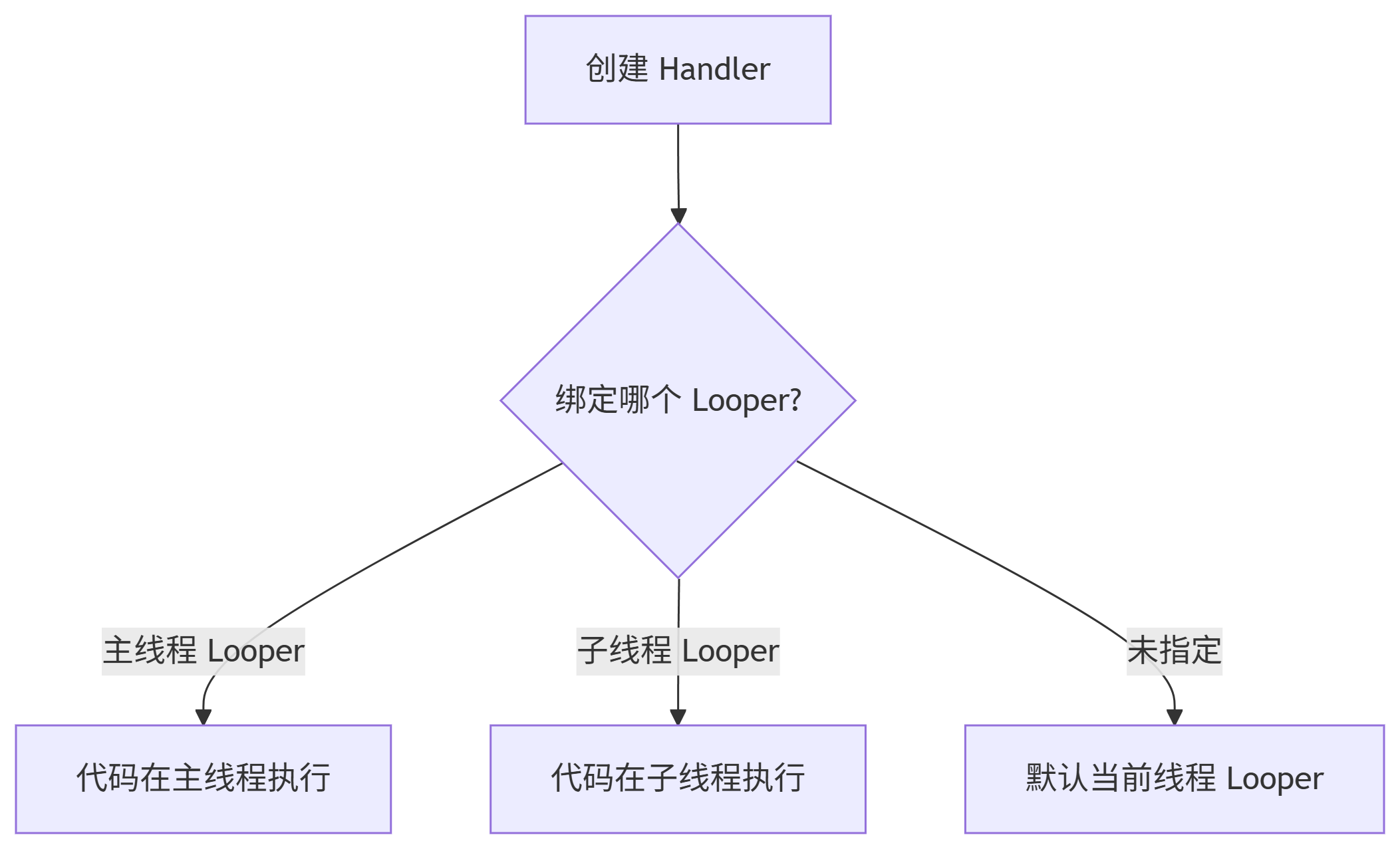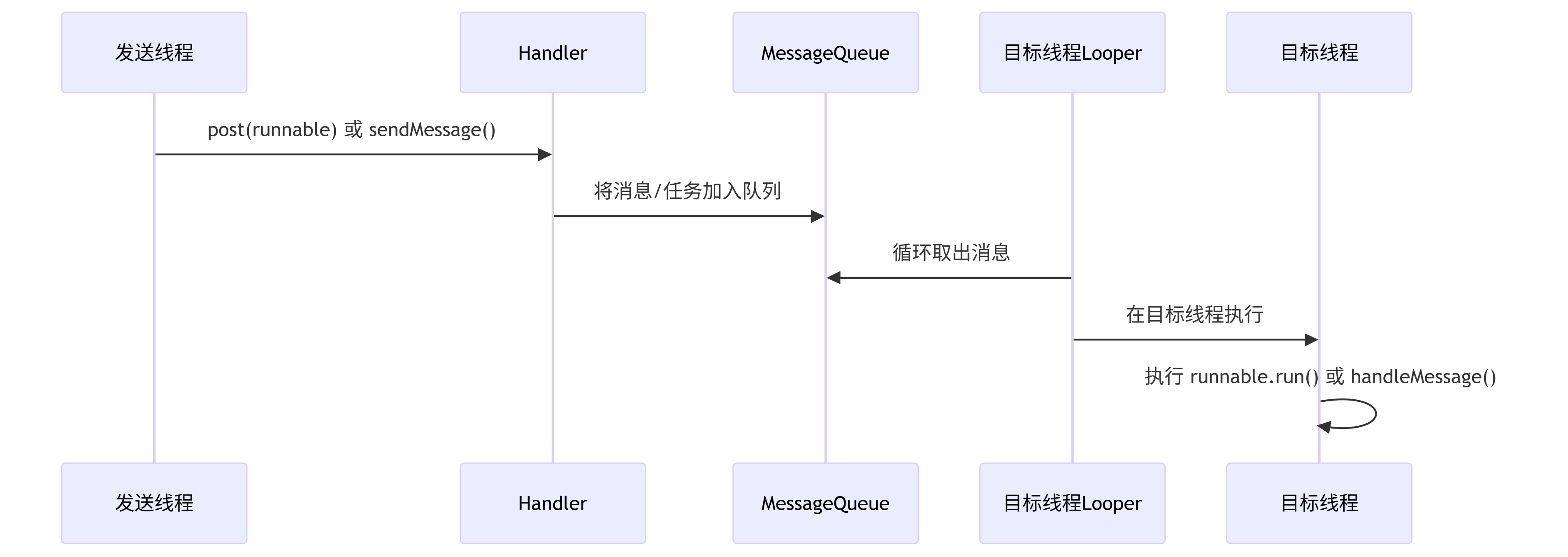Android Handler 线程执行机制
在 Android 中,Handler 中的代码是由创建该 Handler 时绑定的 Looper 所在的线程执行的。这是 Android 线程通信模型的核心机制,下面我将详细解释其原理和使用场景。
核心原理图解

执行场景分析
1. 主线程 Handler(UI 线程)
// 在主线程创建
Handler mainHandler = new Handler(Looper.getMainLooper());// 在任何线程发送任务
new Thread(() -> {mainHandler.post(() -> {// 这段代码在主线程执行textView.setText("Updated from UI thread");});
}).start();特点:
使用
Looper.getMainLooper()绑定主线程适合更新 UI
执行线程:主线程(UI 线程)
2. 子线程 Handler(工作线程)
// 创建带 Looper 的工作线程
HandlerThread workerThread = new HandlerThread("Worker");
workerThread.start();// 绑定工作线程的 Looper
Handler workerHandler = new Handler(workerThread.getLooper());// 发送任务
workerHandler.post(() -> {// 这段代码在 workerThread 执行performLongOperation(); // 耗时操作
});特点:
绑定特定子线程的 Looper
适合后台任务
执行线程:创建 Looper 的子线程
3. 当前线程 Handler
new Thread(() -> {Looper.prepare(); // 初始化当前线程的 LooperHandler threadHandler = new Handler(); // 默认绑定当前线程threadHandler.post(() -> {// 在当前子线程执行Log.d("CurrentThread", Thread.currentThread().getName());});Looper.loop(); // 启动消息循环
}).start();特点:
默认绑定创建 Handler 的线程
需要手动
Looper.prepare()和Looper.loop()执行线程:创建 Handler 的线程
底层机制详解
消息处理流程

关键源码分析
// Handler.java
public void dispatchMessage(Message msg) {if (msg.callback != null) {// 执行 Runnablemsg.callback.run(); // 在Looper所在线程执行} else {if (mCallback != null) {if (mCallback.handleMessage(msg)) {return;}}handleMessage(msg); // 在Looper所在线程执行}
}// Looper.java
public static void loop() {final Looper me = myLooper();final MessageQueue queue = me.mQueue;for (;;) {Message msg = queue.next();if (msg == null) {return;}// 关键:在Looper所在线程执行msg.target.dispatchMessage(msg);}
}执行线程判断表
| Handler 创建方式 | 代码执行线程 | 典型使用场景 |
|---|---|---|
new Handler(Looper.getMainLooper()) | 主线程 | UI 更新 |
new Handler(handlerThread.getLooper()) | 指定子线程 | 后台任务处理 |
new Handler()(在主线程) | 主线程 | 默认 UI 处理 |
new Handler()(在子线程 + Looper) | 创建 Handler 的子线程 | 线程内任务调度 |
view.post(runnable) | 主线程 | View 相关操作 |
常见问题与解决方案
Q:如何在子线程更新 UI?
// 方案1:使用主线程 Handler
new Thread(() -> {// 后台工作runOnUiThread(() -> {// 在主线程更新 UItextView.setText("Done");});
}).start();// 方案2:使用 View.post()
imageView.post(() -> {imageView.setImageBitmap(bitmap);
});Q:Handler 内存泄漏
// 正确做法:静态内部类 + 弱引用
private static class SafeHandler extends Handler {private final WeakReference<Activity> weakActivity;SafeHandler(Activity activity) {super(Looper.getMainLooper()); // 明确绑定主线程this.weakActivity = new WeakReference<>(activity);}@Overridepublic void handleMessage(Message msg) {Activity activity = weakActivity.get();if (activity != null) {// 安全操作}}
}常见用法
明确指定 Looper:
// 总是显式指定 Looper new Handler(Looper.getMainLooper()); // 不依赖创建位置UI 操作使用主线程 Handler:
// 专用 UI Handler private final Handler uiHandler = new Handler(Looper.getMainLooper());void updateUI(String text) {uiHandler.post(() -> textView.setText(text)); }后台任务使用工作 Handler:
// 创建工作线程 Handler private Handler workerHandler;void initWorker() {HandlerThread thread = new HandlerThread("Worker");thread.start();workerHandler = new Handler(thread.getLooper()); }void processData(Data data) {workerHandler.post(() -> {// 耗时操作}); }避免在子线程创建无 Looper 的 Handler:
// 错误示例(会崩溃) new Thread(() -> {Handler handler = new Handler(); // 抛出异常! }).start();
总结
Handler 中的代码在哪个线程执行?
Handler 中的代码执行线程取决于创建 Handler 时绑定的 Looper:
主线程执行:
使用
new Handler(Looper.getMainLooper())创建通过
View.post()发送的任务在主线程创建的默认 Handler
子线程执行:
绑定子线程 Looper 的 Handler(如 HandlerThread)
在子线程创建并初始化了 Looper 的 Handler
执行机制:
所有发送到 Handler 的消息/任务,都会被放入关联的 MessageQueue
Looper 在绑定线程中不断循环取出消息
最终在 Looper 所在线程执行
dispatchMessage()
